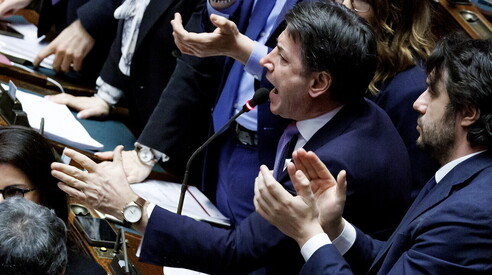"Two million homes up for auction!" Conte and the mortgage scare that didn't exist


A year ago, the president of the Five Star Movement said that a huge number of families "can't afford their payments." But the data now shows that the mortgage default rate is 0.5%, a record low. Alarmism as a method of opposition doesn't work.
On the same topic:
In March 2024, during the Chamber of Deputies debate on Giorgia Meloni's communications ahead of the European Council, Giuseppe Conte cried out in pain: "Do you know that two million families are losing their homes to auction because they can't pay their mortgages?! They are our fellow citizens! And at the same time, you have allowed the banks to distribute €28 billion in profits precisely for those mortgages. How can you sleep at night?!"
The Five Star Movement leader had a grudge against the Prime Minister, guilty of failing to raise bank taxes while, he claimed, Italian families were losing their homes. Conte spoke at length about the social catastrophe that was about to hit the country in various speeches in Parliament, on television, and on social media. What has become of that alarm, more than a year later?
The answer comes from CRIF , a company specializing in credit information analysis. "Mortgage risk is at an all-time low: the mortgage default rate in March 2025 stood at 0.5%." The default rate is defined as "90 past due," or the percentage of loans with at least three installments (90 days) past due in a year compared to the total. "We expect credit quality to stabilize," comments Simone Capecchi, executive director of CRIF, "with default rates remaining at very low levels, well below those of previous crises." For comparison, the default rate during Conte's two governments between 2018 and 2021 ranged between 1% and 1.5%: double to triple.
According to the CRIF Barometer, in the first six months of 2025 , household mortgage applications increased by 20% compared to the same period in 2024, primarily due to the growth in mortgage refinancing (+63.2%), driven by lower interest rates and households' decision to switch to fixed-rate mortgages. Although the cost of mortgages remains higher than the pre-Covid average, delinquency remains at an all-time low.
The increase in mortgage demand has been a trend that has continued for a year. According to data from the Bank of Italy , new mortgages will rise to €44 billion in 2024, up from €41 billion in 2023. To mitigate the uncertainty following the rate hikes of previous years, new fixed-rate mortgages exceeded 90% of the total in 2024 (an all-time record) and represent approximately three-quarters of existing mortgages.
If the increase in mortgage demand is the product of the ECB 's monetary policy, which has cut interest rates, the same cannot be said for default rates. Last year, when Conte raised the alarm, the default rate was at the same level as it is now: 0.5%. A record low. In short, there was no need to wait a year to discover that the accusation would prove unfounded. It was already false then.
But where did Conte get that number from? It was a newspaper article that prominently reported the results of a survey in which respondents expressed their difficulty paying their mortgages. But these numbers, then as now, were incompatible with reality. In Italy, out of 25.7 million families, approximately 3.5 million have an existing mortgage. It's immediately clear that it's impossible that 2 million of them (about 60%) couldn't pay their mortgages.
If Conte had thought about it a little, he would have realized that this scenario contradicted the other half of the narrative: the banks distributing tens of billions in dividends and the government avoiding taxing excess profits. Because if 60% of families had truly stopped paying their mortgages, the banks—over 420 billion euros in mortgage debt—would not only not have cashed in on all these profits, but would also have gone bankrupt. The family crisis would have become a massive banking crisis, and both homes and bank branches would have gone up for auction. Yet the banks are very solid. According to ABI data, 2024 ended with approximately 30 billion euros in non-performing loans (1.5% of total loans). This is significantly lower than a few years ago, when they well exceeded 100 billion euros.
Regardless of the specific issue, this isn't the first time an imminent social catastrophe has been predicted due to some measure taken (or not taken) by the government. This happened already at the end of 2023, with the abolition of the Citizen's Income (Rdc) , replaced by the Inclusion Allowance (Adi), which has much more restrictive criteria. A sharp deterioration in families' living conditions was predicted, and street protests and mass mobilizations were envisioned. Istat data indicate that in 2024, the risk of poverty remained unchanged compared to 2023, and demonstrations in defense of the Rdc were virtually nonexistent.
Something similar happened with the Superbonus : on the one hand, the opposition capitalized on the protests of the "exodati" (those who had been forced out of work), while on the other, it feared a sharp increase in unemployment, especially in the construction sector, due to the end of the generous stimulus. This hasn't happened: the employment rate is at an all-time high, and unemployment remains very low for Italy (around 6%). The same failed referendum on jobs, promoted by the CGIL ( Italian General Confederation of Labour), was based on unfounded premises, such as the explosion of precarious employment.
Describing Italy in recent years as a country where poverty and precariousness are increasing, and millions of families are losing their homes at auction, doesn't reflect reality. But this doesn't matter much in politics. What isn't clear to the opposition, and in politics it should matter, is that this narrative strategy isn't taking a vote away from Giorgia Meloni.
More on these topics:
ilmanifesto





